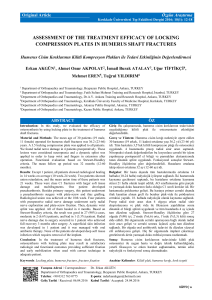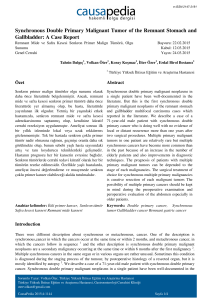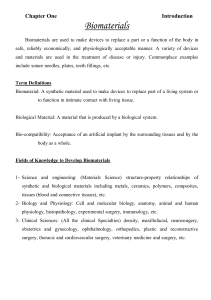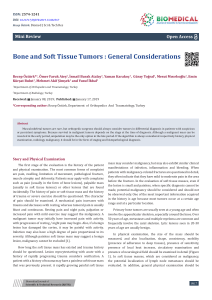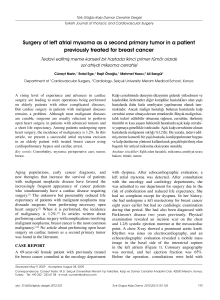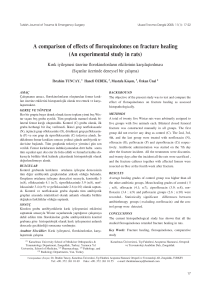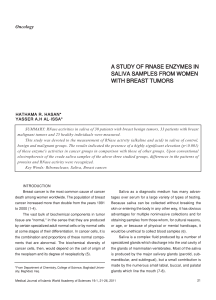Uploaded by
common.user2111
December 2018 1543667138 145 - ismail burak atalay
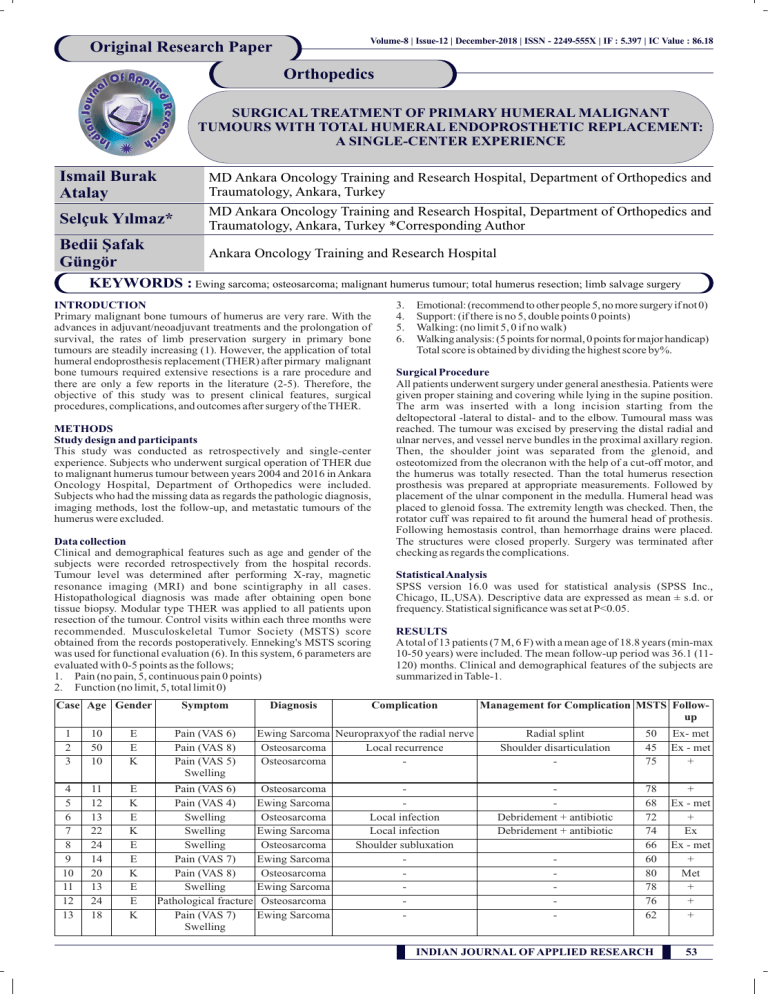
Volume-8 | Issue-12 | December-2018 | ISSN - 2249-555X | IF : 5.397 | IC Value : 86.18 Original Research Paper Orthopedics SURGICAL TREATMENT OF PRIMARY HUMERAL MALIGNANT TUMOURS WITH TOTAL HUMERAL ENDOPROSTHETIC REPLACEMENT: A SINGLE-CENTER EXPERIENCE Ismail Burak Atalay MD Ankara Oncology Training and Research Hospital, Department of Orthopedics and Traumatology, Ankara, Turkey Selçuk Yılmaz* MD Ankara Oncology Training and Research Hospital, Department of Orthopedics and Traumatology, Ankara, Turkey *Corresponding Author Bedii Şafak Güngör Ankara Oncology Training and Research Hospital KEYWORDS : Ewing sarcoma; osteosarcoma; malignant humerus tumour; total humerus resection; limb salvage surgery INTRODUCTION Primary malignant bone tumours of humerus are very rare. With the advances in adjuvant/neoadjuvant treatments and the prolongation of survival, the rates of limb preservation surgery in primary bone tumours are steadily increasing (1). However, the application of total humeral endoprosthesis replacement (THER) after pirmary malignant bone tumours required extensive resections is a rare procedure and there are only a few reports in the literature (2-5). Therefore, the objective of this study was to present clinical features, surgical procedures, complications, and outcomes after surgery of the THER. METHODS Study design and participants This study was conducted as retrospectively and single-center experience. Subjects who underwent surgical operation of THER due to malignant humerus tumour between years 2004 and 2016 in Ankara Oncology Hospital, Department of Orthopedics were included. Subjects who had the missing data as regards the pathologic diagnosis, imaging methods, lost the follow-up, and metastatic tumours of the humerus were excluded. Data collection Clinical and demographical features such as age and gender of the subjects were recorded retrospectively from the hospital records. Tumour level was determined after performing X-ray, magnetic resonance imaging (MRI) and bone scintigraphy in all cases. Histopathological diagnosis was made after obtaining open bone tissue biopsy. Modular type THER was applied to all patients upon resection of the tumour. Control visits within each three months were recommended. Musculoskeletal Tumor Society (MSTS) score obtained from the records postoperatively. Enneking's MSTS scoring was used for functional evaluation (6). In this system, 6 parameters are evaluated with 0-5 points as the follows; 1. Pain (no pain, 5, continuous pain 0 points) 2. Function (no limit, 5, total limit 0) Case Age Gender Symptom 1 2 3 10 50 10 E E K Pain (VAS 6) Pain (VAS 8) Pain (VAS 5) Swelling 4 5 6 7 8 9 10 11 12 13 11 12 13 22 24 14 20 13 24 18 E K E K E E K E E K Pain (VAS 6) Pain (VAS 4) Swelling Swelling Swelling Pain (VAS 7) Pain (VAS 8) Swelling Pathological fracture Pain (VAS 7) Swelling Diagnosis 3. 4. 5. 6. Emotional: (recommend to other people 5, no more surgery if not 0) Support: (if there is no 5, double points 0 points) Walking: (no limit 5, 0 if no walk) Walking analysis: (5 points for normal, 0 points for major handicap) Total score is obtained by dividing the highest score by%. Surgical Procedure All patients underwent surgery under general anesthesia. Patients were given proper staining and covering while lying in the supine position. The arm was inserted with a long incision starting from the deltopectoral -lateral to distal- and to the elbow. Tumoural mass was reached. The tumour was excised by preserving the distal radial and ulnar nerves, and vessel nerve bundles in the proximal axillary region. Then, the shoulder joint was separated from the glenoid, and osteotomized from the olecranon with the help of a cut-off motor, and the humerus was totally resected. Than the total humerus resection prosthesis was prepared at appropriate measurements. Followed by placement of the ulnar component in the medulla. Humeral head was placed to glenoid fossa. The extremity length was checked. Then, the rotator cuff was repaired to fit around the humeral head of prothesis. Following hemostasis control, than hemorrhage drains were placed. The structures were closed properly. Surgery was terminated after checking as regards the complications. Statistical Analysis SPSS version 16.0 was used for statistical analysis (SPSS Inc., Chicago, IL,USA). Descriptive data are expressed as mean ± s.d. or frequency. Statistical significance was set at P<0.05. RESULTS A total of 13 patients (7 M, 6 F) with a mean age of 18.8 years (min-max 10-50 years) were included. The mean follow-up period was 36.1 (11120) months. Clinical and demographical features of the subjects are summarized in Table-1. Complication Management for Complication MSTS Followup Ewing Sarcoma Neuropraxyof the radial nerve Osteosarcoma Local recurrence Osteosarcoma - Radial splint Shoulder disarticulation - 50 45 75 Ex- met Ex - met + Osteosarcoma Ewing Sarcoma Osteosarcoma Ewing Sarcoma Osteosarcoma Ewing Sarcoma Osteosarcoma Ewing Sarcoma Osteosarcoma Ewing Sarcoma Debridement + antibiotic Debridement + antibiotic 78 68 72 74 66 60 80 78 76 62 + Ex - met + Ex Ex - met + Met + + + Local infection Local infection Shoulder subluxation - - INDIAN JOURNAL OF APPLIED RESEARCH 53 Volume-8 | Issue-12 | December-2018 | ISSN - 2249-555X | IF : 5.397 | IC Value : 86.18 Postoperative MSTS score average of our patients was 71%. The images of the case are exemplified in Figure 1. Figure 1: An exemplary image of total humerus endoprosthesis replacement in a a patient with osteosarcoma Magnetic resonance images show the heterogeneous mass with soft tissue component, causing destruction in the proximal part of the humerus and intramedullary edemain the T1 weighted coronal (left image) and T2 weighted axial (right image)views. Intraoperative picture shows preservation of the extremity length as well as the radial and ulnar nerves by hanging(arrows). X ray designates the postoperative control of the prosthesis As for the complications; local recurrence was seen in three patients. Infection requiring debridement was seen in two patients as well as radial nerve neuropraxy (temporary and resolved within three months) was seen in one patients. One patient underwent shoulder disarticulation due to local recurrence. Five patients died within the five years after surgery. All dead patients had metastasis. Five-year survival was 66.6% for osteosarcoma patients while 25% for Ewing sarcoma. DISCUSSION Osteosarcoma –the most common and highly malignant bone tumouroccurs predominantly in the upper (humerus) limbs and lower limbs (femur and tibia) of young adults and adolescents (7,8). On the other hand, Ewing sarcoma, the most common malignant bone tumour following osteosarcoma, can be seen either as a bone or soft tissue sarcoma depending on the tumoural origin (9-11). Although several resection and reconstruction procedures were previously described for the malignant tumours of humerus, some cases require massive resection (1,12-15). In this context, total humerus resection and endoprosthesis replacement is a quite rare surgical procedure. identified in one patient. Subluxation of prosthetic humeral head was noted in 3 patients. Average MSTS score was 71.5%. The aforementioned three studies highlight the THER as a viable treatment option in indicated patients, with a low complication. Nonetheless, although THER is quite effective for reducing pain, it has low priority for the functionality. In our study, the sample size is acceptable compared with the previous studies. Because bone tumors were more common in men, the number of male patients was greater than the number of female patients. The mean age was also consistent with other studies and literature whereby most of the cases were adolescences and young adults. All the patients included in our study have primary bone tumor diagnosis. We did not consider one-year survival, however five-year survival was 66.6% and 25% for osteosarcoma and Ewing sarcoma patients, respectively. Our sample's survival rate was relatively shorter than the previous studies. This fact could be attributed to the heterogeneity of the clinical features and recurrences. Four of five patients who had recurrence died within the five year. We can highlight that recurrence is a predictive parameter for five-year survival. Infection requiring local debridement plus antibiotic therapy, local recurrence, and temporary neuropraxy were the complications seen in our study. The MSTS of our study was consistent with the previous studies. We did not encounter the subluxation of prosthetic humeral head as in the study done by Kotwal's et al (5). By the way, lack of assessment blood loss and surgery duration as Kotwal et al did, is a limitation of our study. Another important limitation is the fact that lack of data with respect to the adjuvant/postoperative chemotherapy or radiotherapy. Although we consult our patients to the medical and radiation oncology departments in our center, we could not obtain the exact data. Lack of postoperative MSTS Score and VAS scores is a limitation as well. Although we did not present the exact data, according to our clinical experience, we can say that pain was the most improved parameter while functional capacity was lowest. In the light of our results, THER is a convenient method for limb salvage surgery for the management of primary malignant humerus tumours. Although THER seems to reduce pain, further studies considering the improvement of functionality with sample sizes are awaited. Acknowledgement: None Conflict of interest: None REFERENCES 1. 2. 3. 4. 5. 6. 7. 8. As regards the THER in the literature, there are only a few studies. Yoshida and Tokusashi (2) reported a 48 year-old-man with a pathological fracture of the humerus. The patient underwent a preoperative chemotherapy followed by wide resection for acquiring a safe margin. Then, a total humerus replacement was performed. Natarajan et al. (4) analyzed the data of 11 patients (mean age of 17 years) with malignant musculoskeletal tumour of the humerus. All patients in their study underwent a limb salvage surgery with THER. They reported one- and five-year survival rates as 90.9% and 77.9%, respectively. MSTS score was 80%. One patient had a forequarter amputation for local recurrence. Puri and Gulia (3) have presented their clinic experience by presenting the data of 20 cases (12 M, 8 F) with a mean age of 22 years. The diagnosis of their sample included osteosarcoma in nine, Ewing sarcoma in eight, and chondrosarcoma in three patients. The survival rate was 52% and MTS score was 22%. Moreover, Kotwal et al (5) reported 20 patients' data in their retrospective study. The diagnosis of their sample included primary malignant bone tumors in eleven, metastatic bone tumors in nine patients. Differently from the previous studies they reported the estimated blood loss and duration of the surgery as 1131 mL and 314 minutes. Deep infection was encountered in one patient requiring debridement while mechanical loosening of ulnar component was 54 INDIAN JOURNAL OF APPLIED RESEARCH 9. 10. 11. 12. 13. 14. 15. Liu T, Zhang Q, Guo X, Zhang X, Li Z, Li X. Treatment and outcome of malignant bone tumors of the proximal humerus: biological versus endoprosthetic reconstruction. BMC Musculoskelet Disord. 2014;15:69. Yoshida Y, Tokuhashi Y. Total humerus replacement for osteosarcoma with proximal part of humerus: a case report. World J Surg Oncol. 2012; 10: 36. Puri A, Gulia A. The results of total humeral replacement following excisionfor primary bone tumour. J Bone Joint Surg Br. 2012;94(9):1277-81. Natarajan M, Sameer M, Kunal D, Balasubramanian N. Custom-made endoprosthetic total humerus reconstruction for musculoskeletal tumours. Int Orthop. 2012;36(1):125-9. Kotwal S, Moon B, Lin P, Satcher R Jr, Lewis V. Total Humeral Endoprosthetic Replacement following Excision of Malignant Bone Tumors. Sarcoma. 2016;2016:6318060. Enneking WF, Dunham W, Gebhardt MC, Malawar M, Pritchard DJ. A system for the functional evaluation of reconstructive procedures after surgical treatment of tumors of the musculoskeletal system. Clin Orthop Relat Res. 1993;(286):241-6. Taran SJ, Taran R, Malipatil NB. Pediatric Osteosarcoma: An Updated Review. Indian J Med Paediatr Oncol. 2017;38(1):33-43. Evola FR, Costarella L, Pavone V, Caff G, Cannavò L, Sessa A, Avondo S, Sessa G. Biomarkers of Osteosarcoma, Chondrosarcoma, and Ewing Sarcoma. Front Pharmacol. 2017;8:150. Ferrari A, Dirksen U, Bielack S. Sarcomas of Soft Tissue and Bone. Prog Tumor Res. 2016;43:128-41. Gutowski CJ, Basu-Mallick A, Abraham JA. Management of Bone Sarcoma. Surg Clin North Am. 2016;96(5):1077-106. Jackson TM, Bittman M, Granowetter L. Pediatric Malignant Bone Tumors: A Review and Update on Current Challenges, and Emerging Drug Targets. Curr Probl Pediatr Adolesc Health Care. 2016;46(7):213-228. Fabroni RH, Castago A, Aguilera AL, Steverlynck AM, Zeballous J. Long-term results of limb salvage with the Fabroni custom madeendoprosthesis. Clin Orhtop Relat Res 1999;35(8):41-52. Mankin HJ, Gebhardt MC, Jennings LC, Springfield DS, Tomford WW: Longtermresults of allograft replacement in the management of bonetumors. Clin Orthop Relat Res 1996;324: 86-97. Muramatsu K, Fukano R, Iwanaga R, Taguchi T. Reconstruction of theproximal humerus by combined use of extracorporeally-irradiatedosteochondral graft and free vascularized fibula following resection of Ewing sarcoma. J Plast Reconstr Aesthet Surg. 2010;63:2177-180. Rose PS, Shin AY, Bishop AT, Moran SL, Sim FH. Vascularized free fubulatransfer for oncogenic reconstruction of the humerus. Clin Orthop Relat Res 2005; 438:80-4.
